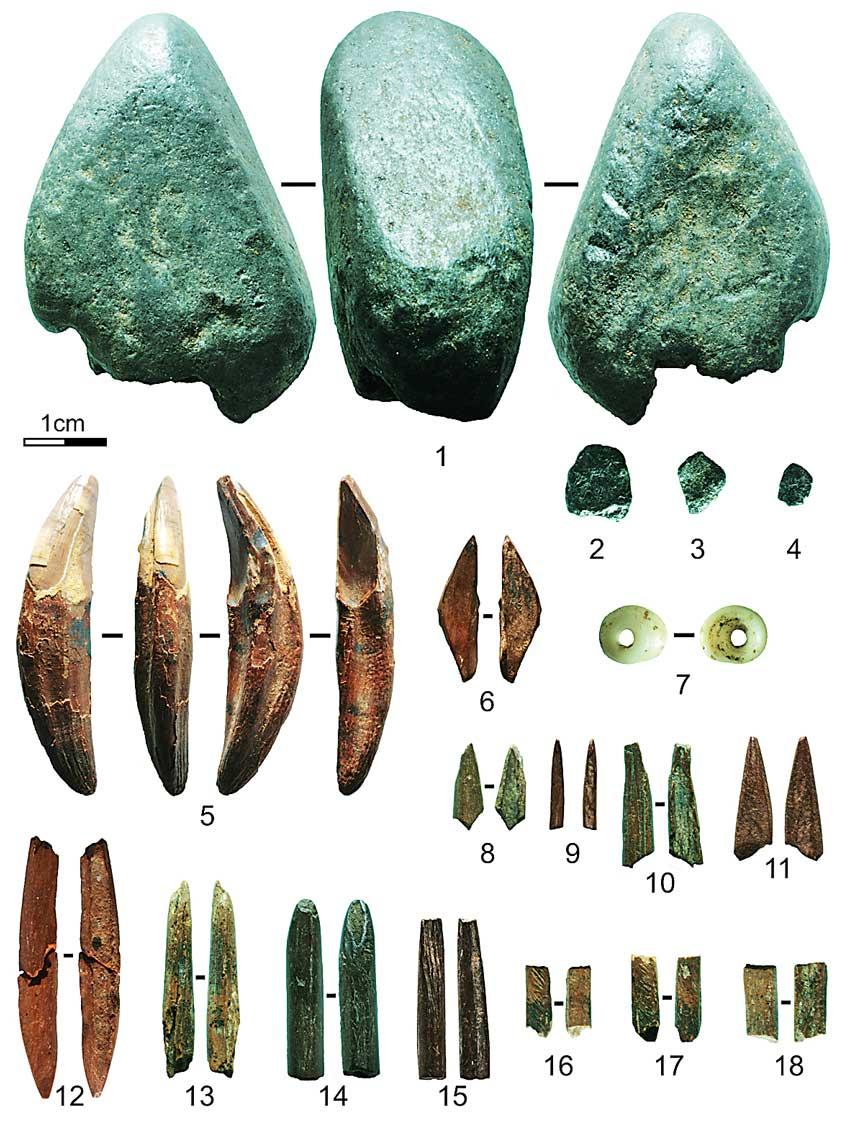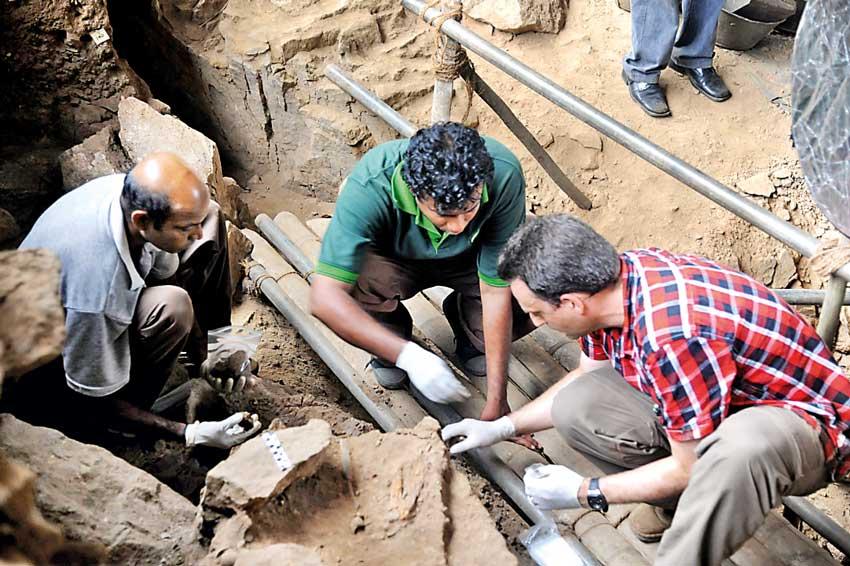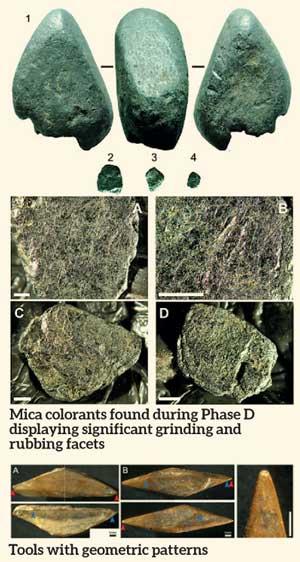18 Jun 2020 - {{hitsCtrl.values.hits}}

Phase D Artefacts with evidence for Late Pleistocene occupation of the cave
First time pre-historic bone tools were found outside Africa
Early humans used clothing to protect themselves against insects
 Historical accounts of the Balangoda Man indicated that Sri Lanka had strong links to a pre-historic era. Sri Lanka’s Fa-Hien Cave, also known as Pahiyangala Cave, is believed to be the site of earliest fossil appearance of Homo sapiens in South Asia. Artifacts found during excavations in the 1980s have proposed that projectile microlith technologies and ochre use appeared in Sri Lanka earlier than in Europe. But with the discovery of more toolkits during re-excavations that happened since 2007, archaeologists were recently able to prove that those artifacts were used somewhere around 48,000 years ago. This evidence further suggests that Osseous (bone) hunting technologies as they are called are believed to have been used in high-velocity projectile hunting of small semi-arboreal and arboreal game. How pre-historic man developed such complex objects with attractive geometric patterns, hunted animals with these weapons and survived within rainforests is indeed a
Historical accounts of the Balangoda Man indicated that Sri Lanka had strong links to a pre-historic era. Sri Lanka’s Fa-Hien Cave, also known as Pahiyangala Cave, is believed to be the site of earliest fossil appearance of Homo sapiens in South Asia. Artifacts found during excavations in the 1980s have proposed that projectile microlith technologies and ochre use appeared in Sri Lanka earlier than in Europe. But with the discovery of more toolkits during re-excavations that happened since 2007, archaeologists were recently able to prove that those artifacts were used somewhere around 48,000 years ago. This evidence further suggests that Osseous (bone) hunting technologies as they are called are believed to have been used in high-velocity projectile hunting of small semi-arboreal and arboreal game. How pre-historic man developed such complex objects with attractive geometric patterns, hunted animals with these weapons and survived within rainforests is indeed a
wow factor.
Fa-Hien Lena and its significance
According to Oshan Wedage, Officer-in-charge of the excavation and lecturer at University of Sri Jayawardenapura, Sri Lanka has many sites that present evidence of rainforest pre-history of early humans. During his 12 years of experience in field excavations he has studied the Beli Lena in Kitulgala, Fa-Hien Cave and Miniathilliya Open Air sites in great detail. “The Beli Lena, Batadomba Lena and Fa-Hien Lena presents similar evidence of rainforest pre-history and human dispersal,” said Wedage while sharing his experience with the Daily Mirror.
According to archaeological evidence, the Fa-Hien Cave is acknowledged as the site of earliest fossil appearance of Homo Sapiens in South Asia. Therefore it is a crucial locale to understand the adaptive capacities and cultural flexibilities as humans first moved throughout the diverse environments of Asia. “Although preliminary excavations were done in the 1980s we re-excavated with a multidisciplinary involvement, this time using new technology,” Wedage added. “Thereafter I invited specialist teams to identify specific details around the cave such as the Fauna. Around this time I got a scholarship to study at the Max Planck Institute for the Science of Human History that studies human evolution. So the artifacts were transported to Germany for further testing. They are in the final stages of testing which will be completed soon,” he said.
The study further revealed that an ongoing analysis of the site has found that it holds the earliest microlith assemblage in the region and further evidence reveals how pre-historic man hunted monkeys and squirrels through the toolkits and weapons found.

During excavations
Mind-blowing technology
Wedage confirmed that this is the first time that bone tools dating back to a pre-historic era were found outside Africa. “It is believed that when early humans moved out of Africa, some went to the North and the others to the South,” he added. “During the Southern dispersal it is believed that they initially settled in the coastal areas of Sri Lanka and later moved towards the interior. This is when they habituated in rainforests, but then the terrain has changed. They had to protect themselves from insects, find protein foods and in turn adapt to a new environment.
This adaptation came in the way of new technology to hunt fast-moving animals such as monkeys and squirrels. For this they made arrowheads out of bone. What’s significant are the different geometric patterns, how some tools are sharp on one side and blunt on the other, their weight, size and other minute details. During the excavations we found a bead made of marine shells and this we believe was made from the exchange of materials. They probably might have exchanged meat or honey and got marine shells in return. Appearance is one of the specialities of H. Sapiens, where they want to look dressed up with decorative pieces,” he explained.
The paper further states that an additional 29 bone implements display morphologies and wear consistent with awls, pegs, wedges and lissoir-tools associated with the workings of skin or plant fibers. Hence the researchers believe that early humans in Sri Lanka made clothing as a layer of protection against insect bites and insect-borne diseases.
A stratigraphical point of view
Wedage’s M. A Thesis was based on ‘Stratigraphical Analysis of Fa-Hien Cave in
Sri Lanka, comparing stratigraphy in 1988 and 2009’ which he obtained from Deccan College of Research and Archaeology. His doctoral thesis is an extension to this and is titled ‘New investigations in to the Late Pleistocene and Early Holocene Rainforest Pre-history of Sri Lanka’. Therefore he pays special attention to the formation of the Fa-Hien Cave. “Within an excavation there are two layers of soil ; the cultural layer and the natural layer,” he explained further. “So my speciality is to study the formation of soil layers. Many factors contribute to this. Soil could deposit from a flood, animals have their own cultural behaviours, people who lived in these caves hunted animals and burnt them. Therefore the ashes will be deposited in the soil. The females would go to collect yams and they would throw the rest of their food because there was no specific waste disposal system then. Likewise I study every detail in the formation of the soil layers and how the deposits formed. This is what a stratigraphical analysis is all about,” said Wedage.
However, the analysis is not yet complete. “We found tiny bone fragments during excavations and we are now trying to find out to which species they belong to,” he continued. “For this we are using a new technology. We are trying to identify the soil DNA and other information. Why we are taking time to finish this is because we want to complete everything at once. If we go for a re-excavation it would be a costly affair,” he went on.
While looking forward to do more projects in the future, Wedage says that any event that took place in the past should be based on actual facts rather than mythical ideologies and that is why there’s a fine line between archaeology and history.
28 Nov 2024 43 minute ago
28 Nov 2024 3 hours ago
28 Nov 2024 4 hours ago
28 Nov 2024 4 hours ago
28 Nov 2024 5 hours ago